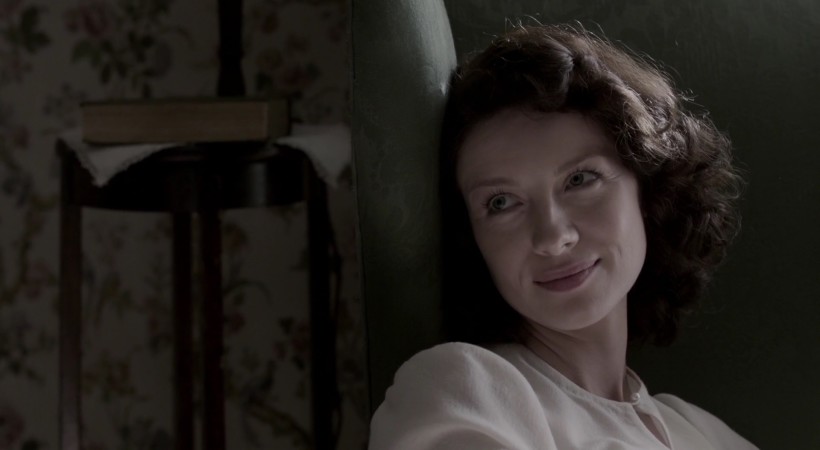Different colors are used throughout the series in reference to both Claire and Jamie. This post is actually a continuation of a former one, White Animals and the King of Ireland, in which I detailed Claire’s association with mainly white animals. My next two posts will be about Jamie’s color which is red and the blue light emitted by healers when treating other characters. The Cherokee shamanistic system represented in the following chart will be used again for interpretation (Mooney, 342).
As demonstrated in my former post about white animals, Claire’s color is white. Her association with the white color continues into later books. At Fort Ticonderoga, she is known as the White Witch. Lord John even sees Claire as “a great white bird with yellow eyes” when he starts smelling ether before his nephew’s operation (An Echo in the Bone, ch. 88). This is contrasting to the dark creatures that other characters see under the effects of ether. In A Breath of Snow and Ashes, Bobby Higgins describes Malva as a terrible, dark form (ch. 42), and Claire sees both Tom Christie and Amy McCallum as black, distorted figures with fangs, after resuscitating Aidan (ch. 50).
Of interest is the description of the deer that frequents William’s plantation in Virginia.
“. . .It’s white, I suppose, but it looks as though it’s made of silver. I don’t know whether it comes only in the moonlight or whether it’s only that I cannot see it save by moonlight – but it is a sight of rare beauty” (An Echo in the Bone, ch.95).
White animals overall are rare. They do not necessarily need to be albino since the genes for white coloring are recessive, so they are unusual. This deer is a strong reference to Claire. She is perceived as “odd” and “different” by people from the eighteenth century. Jamie describes her as rare before their separation in Dragonfly in Amber (ch. 46):”Lord, ye gave me a rare woman, and God! I loved her well.” Oddness is associated with rareness. Of interest is the fact that Lord John relates this description of the white deer after starting a conversation about sexual partners and his appreciation of Jamie’s friendship, and requesting Claire to see her naked body. Due to his same-sex preferences, Lord John thinks that Claire might perceive him as odd:
“May I . . . You will think me odd.”
“Well, you are a bit odd, aren’t you?” I said tolerantly. “I don’t really mind, though. What is it?”
He gave me a look, strongly suggesting that if one of us was indeed odd, he didn’t think it was himself. . . (An Echo in the Bone, ch. 95)
The truth is that they are both perceived as “odd.” Claire is not only perceived as unusual in the eighteenth century but also in the twentieth century. In the 1950s, the choice that Claire made in studying medicine and having a career instead of staying at home with her daughter was viewed as different and radical. Similarly, her friend, Joe Abernathy is an exceptional case too. Due to his skin colour, he was not expected to be a medical doctor. No wonder Claire and Joe became good friends – they have many things in common. When it comes to Lord John, having a same-sex preference in the eighteenth century is a curse since he is running the risk of being executed for it. However, this “distinct” characteristic has allowed him to understand, tolerate or befriend characters who are just simply different from the rest or who behave outside of the norm.
Up to recently I thought that Claire was the only character associated with white animals. This is no longer the case since they are some instances in MOBY in which Rachel Hunter is portrayed as a white bird. When Jamie applies the war paint to his nephew’s body, he draws a “V” on Ian’s right shoulder, a white dove which is a representation of Rachel (MOBY, ch. 66). The white dove is a symbol of peace and love in different cultures, attributes that Rachel possesses. Furthermore, the conversation between Jamie and Ian regarding the usage of the white color in the Amerindian traditions confirms what is specified in the Cherokee shamanistic system.
. . .”Did ye not tell me once the white is for peace, though?”
“Aye, should ye be going to parley or trade, ye use a good deal of white. But it’s for the mourning, too – so if ye go to avenge someone, ye’d maybe wear white” (MOBY, ch. 66).
Ian then reveals that the white arrow on his forehead is for Flying Arrow, the Mohawk whose place he took when he was adopted. Ian also explains that the arrow is not for vengeance but for mourning. Of interest is the fact that the name of Flying Arrow foreshadows Ian getting hurt by an arrow. Overall, it seems that Rachel would be following Claire’s footsteps.
Thanks for reading my blog. My next post will be about Jamie’s color, which is red.
Featured image is from Outlander Online.
Excerpts from
Gabaldon, Diana. A Breath of Snow and Ashes. 2005. New York: Bantam Dell. 2006. Print.
– – -. An Echo in the Bone. 2009. New York: Bantam Dell. 2011. Print.
– – -. Written In My Own Heart’s Blood. 2014. New York: Bantam Dell. 2015. Print.
Mooney, James. Cherokee History, Myths and Sacred Formulas. Cherokee: Cherokee Publications. 2006. Print.
